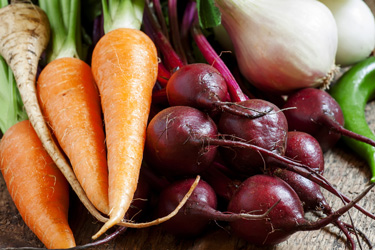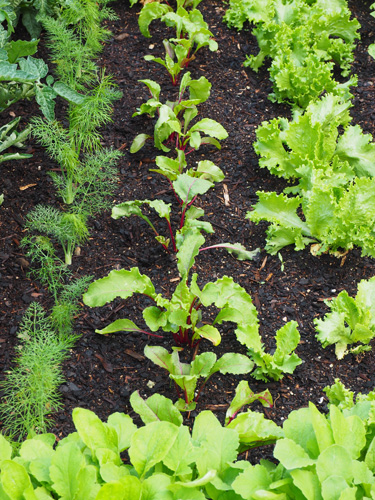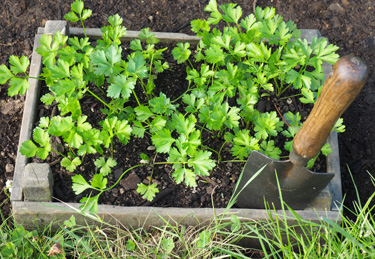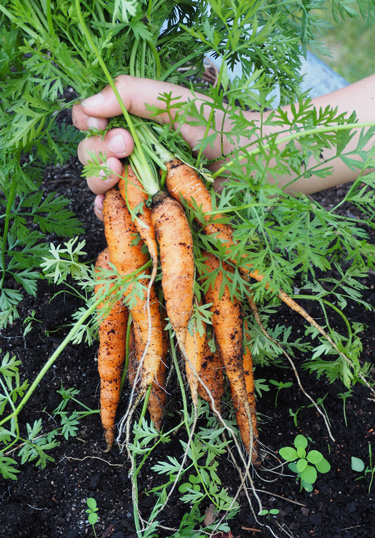Soul food
When you’re still picking summer’s tomatoes, capsicums and cucurbits, the challenge at this time of year can be finding enough space to plant winter crops. But it’s a good time
to start seedlings in containers for transplanting out later. Or grow some herbs and salad greens in containers for a quick autumn crop, although pots will need lots of watering if dry weather persists.
Northern gardeners have plenty of time to plant cabbages and broccoli but in the cooler middle and southern regions these vegetables need planting earlier to make the most of the warm weather and get their roots well established by winter. Brussels sprouts are cool-climate treats well worth growing if your winter is prone to frost, but get them in soon. Meanwhile in the ‘winterless’ north there is still time to sow another
batch of summer beans.
March is a good time to plant herbs and leafy greens, including lettuce, rocket, silverbeet and spinach. Carrots, beetroot and other root vegetables are best sown directly into well prepared crumbly garden soil to avoid disturbing their roots with transplanting.
Beetroot is easy to grow form seed in a sunny patch of garden soil, or in a large container filled with planting mix. Try out the different beetroot varieties in different shapes and colours. There are globe shaped beetroot and long cylinder ones. Also yellow beetroot and striped beetroot.
Carrots come in a range of shapes, sizes and colours, with some interesting heritage varieties. For containers and heavier soils quick maturing baby carrots and other shorter varieties are ideal.
Growing beetroot and carrots in containers is a great way to control the quality of your growing media and raise soil temperature for quicker winter growth. The trick is to pay special attention to watering and feed with liquid fertiliser every 2 to 3 weeks. Choose a large container to help retain moisture. It should have adequate drainage and a depth of at least 30cm.
Broad beans and peas sown in autumn and early winter germinate well in cool soil. Sow direct into well drained compost enriched soil or large containers. As legumes they will fix their own nitrogen so they don’t need nitrogen rich fertiliser and are a good crop to grow ahead of a spring sown root crop or leafy greens.
Autumn is also a key planting time for members of the onion family, with lots of interesting varieties of leeks, multiplying onions, shallots and sing onions to try. Garlic, traditionally planted on the shortest day and harvested on the longest, can be planted successfully from April onwards.
Direct sowing
Root vegetables, peas and beans are among those vegetables that grow best when their roots are left undisturbed. The seed is sown straight into position, either in a well prepared garden bed or a large container filled with planting mix.
Start with careful soil preparation in a sunny location. The soil should drain freely and have a loose, even texture. To grow nice straight carrots, make sure there are no lumps of compacted soil and stones. Position support structures for peas and beans before you sow.
Water gently to moisten the soil before sowing. Gently tap fine seeds (e.g carrots) out of the packet as evenly as possible, or place large seeds (e.g peas) at the recommended spacing. To water, use a soft spray hose or watering can to keep the soil moist without flooding.
Thinning
Once carrot or beetroot seedlings are 3-5cm tall it’s time to sacrifice a few seedlings to make room for others to grow. Leave about 2-3cm between each seedling. As the plants grow, thin them some more. You can eat the thinnings.
Seed sowing tips
- Soak beetroot seed in water for two hours before planting.
- Sow a batch of seeds every few months for a continuous supply.
- Cover trays with plastic wrap to keep the seed raising mix warm until the seeds have germinated (two to three weeks).
- Keep the soil just moist, not wet. A plastic mist spray bottle is ideal for this.
Carrot tricks
- For a continuous supply sow carrots every 3-4 weeks.
- In cold climates, sow your last batch of seed 2-3 months before heavy frost. Carrots will survive light frosts.
- Sow radishes and carrots together. The radishes grow much faster and are ready before the carrots.
- Mix carrot seeds with used coffee grounds before sowing. This will help you space the seeds and also repels pests.
- A fine layer of organic mulch, such as pea straw or used coffee grounds helps prevent a dry surface crust, which can be a barrier for germination.
- The ideal soil for root veges is where there previously grew a well-fertilised crop of leafy greens.
- Feed carrots only once they are growing strongly. Avoid excessive nitrogen fertiliser.
- Water to keep the soil evenly moist, especially while the weather is hot.
Autumn projects
Build a compost heap. When the leaves start to fall from the trees and the lawn has its autumn growth spurt you’ll have nature’s perfect ingredients with which to build your soil.
Squirrel a winter supply. Don’t waste a thing. Pick and preserve tomatoes, peppers, herbs in what ever way you prefer - bottle, freeze, or dry.
Harvest and store pumpkins in a cool dry place. Cure in the sun before storage and leave the stalks on for longer keeping.
Plant a citrus tree. If you already have citrus in your garden, consider planting another variety with a different fruiting time. Its possible to have fruit all year round in a warm climate.
Build a raised bed. Raising the soil level is a great way to make gardening easier on your back while improving soil drainage faster healthier vege growth, especially in winter if you have heavy clay soil.
Build a cloche cover. Whether birds are your main problem or your plants need protection from winter cold, convenient crop covers are worth their weight in gold.
Revamp the watering system while the leaks and deficiencies of the past few months are still fresh in your mind.

28-Feb-2021

Parsnip, carrots, beetroot and onion

Row of beetroot

Celery seedlings

Freshly pulled carrots

